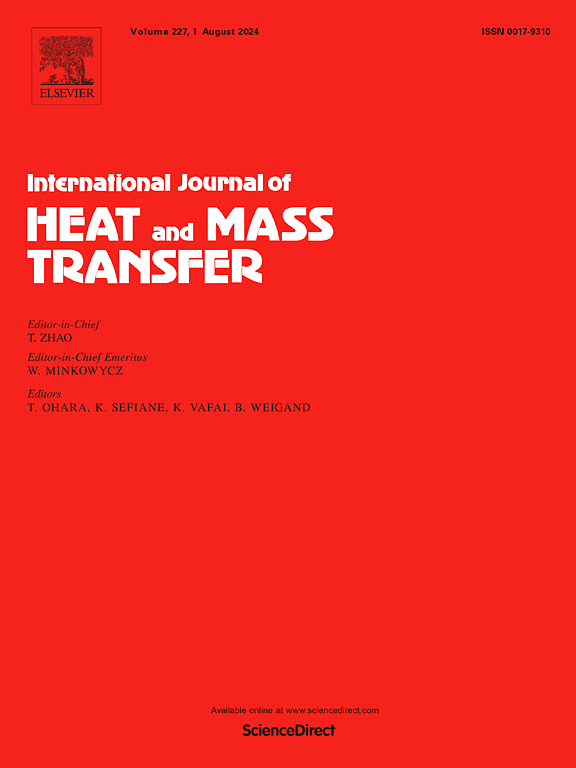由特斯拉微通道组成的相对较大的铜制散热器中的流动沸腾
IF 5
2区 工程技术
Q1 ENGINEERING, MECHANICAL
International Journal of Heat and Mass Transfer
Pub Date : 2024-10-29
DOI:10.1016/j.ijheatmasstransfer.2024.126366
引用次数: 0
摘要
铜制微通道散热器中的流动沸腾被广泛用于大功率电子模块的冷却,尤其是尺寸较大的 IGBT 功率电子模块。然而,由于长期存在的蒸汽回流和液体供应问题严重恶化了流动沸腾传热,因此要显著提高铜微槽的流动沸腾性能具有挑战性。此外,大型散热器的通道长度与水力直径比(L/Dh)过高也不利于有效的两相传输,从而导致沸腾危机的提前发生。在这项工作中,设计并制造了一个相对较大的铜制散热器(长×宽=10 厘米×5 厘米),该散热器由特斯拉微通道组成,具有良好的流动二重性。设计的散热器的长宽比约为 220,远大于已报道的研究结果。在这种新型散热器中,每个通道中的周期性特斯拉阀门结构能够抑制严重的蒸汽倒流,从而显著增强两相传输,进而延缓加热表面的干燥。为了证明我们设计的优势,实验研究了传热系数(HTC)、临界热通量(CHF)和两相流稳定性等方面的流动沸腾性能,并与由平壁微通道组成的散热器进行了综合比较。实验在去离子水中进行,入口总流量从 20 毫升-分钟-1 到 50 毫升-分钟-1 不等。研究结果表明,由于成功抑制了两相回流和高效的两相传输,流动沸腾性能和两相流稳定性得到了显著提高。例如,在流速为 50 ml-min-1 时,该设计在前进方向的 CHF 和 HTC 分别约为 30.6 W-cm-2 和 49.7 kW-m-2K-1,与采用平壁微通道的散热器相比,分别显著提高了 57.4% 和 106.7%。此外,传统散热器的壁温和压降标准偏差(STD)分别是这种新型散热器的 17.1 倍和 12.6 倍。为阐明特斯拉阀门在调节蒸汽回流方面的工作机制,还进行了可视化研究。本文章由计算机程序翻译,如有差异,请以英文原文为准。
Flow boiling in a relatively large copper heat sink comprised of Tesla microchannels
Flow boiling in copper microchannel heat sink is widely used for the cooling of high power electronic modules, particularly the IGBT power electronic modules with large sizes. However, it is challenging to significantly enhance the flow boiling performance of copper microchannel heat sink due to the long-lasting issue of vapor backflow and liquid supply that severely deteriorates flow boiling heat transfer. Also, a high channel length to hydraulic diameter ratio (L/Dh) of a large heat sink is not favorable for efficient two-phase transport, resulting in the early occurrence of boiling crisis. In this work, a relatively large copper heat sink (L × W = 10 cm × 5 cm) comprised of Tesla microchannels characterized with excellent flow diodicity was designed and fabricated. The L/Dh ratio of the as-designed heat sink is about 220, which is much larger than the reported studies. In this new heat sink, the periodic Tesla valve structures in each channel is capable of inhibiting the severe vapor backflow to dramatically enhance the two-phase transport and then delay the dryout of heating surface. To demonstrate the advantages of our design, the flow boiling performances in terms of heat transfer coefficient (HTC), critical heat flux (CHF), and two-phase flow stabilities were experimentally studied and a comprehensive comparison against a heat sink consisted of plain-wall microchannels is presented. Experiments were conducted on DI-water with total inlet flow rate varying from 20 ml·min-1 to 50 ml·min-1. The results of this study show that flow boiling performances and two-phase flow stabilities are significantly enhanced owing to the successful suppression of two-phase backflow and efficient two-phase transport. For example, at a flow rate of 50 ml·min-1, the CHF and HTC of this design in the forward direction are about 30.6 W·cm-2 and 49.7 kW·m-2K-1, respectively, accompanied by significant enhancements of 57.4 % and 106.7 %, respectively, in contrast to the heat sink with plain wall microchannels. Additionally, the standard deviations (STD) of wall temperature and pressure drop of the conventional heat sink are 17.1 and 12.6 times higher than that of this new heat sink. Visualization studies were conducted to elucidate the working mechanism of Tesla valves in regulating vapor backflow.
求助全文
通过发布文献求助,成功后即可免费获取论文全文。
去求助
来源期刊
CiteScore
10.30
自引率
13.50%
发文量
1319
审稿时长
41 days
期刊介绍:
International Journal of Heat and Mass Transfer is the vehicle for the exchange of basic ideas in heat and mass transfer between research workers and engineers throughout the world. It focuses on both analytical and experimental research, with an emphasis on contributions which increase the basic understanding of transfer processes and their application to engineering problems.
Topics include:
-New methods of measuring and/or correlating transport-property data
-Energy engineering
-Environmental applications of heat and/or mass transfer

 求助内容:
求助内容: 应助结果提醒方式:
应助结果提醒方式:


